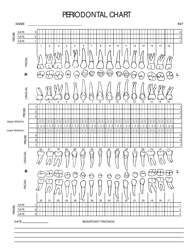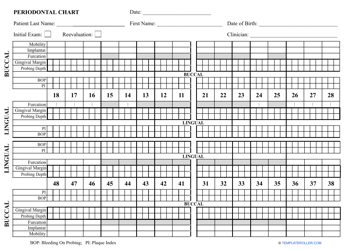Periodontal Chart Template
A Periodontal Chart Template is used by dentists to track and record the condition of a patient's gums and teeth. It helps in diagnosing and treating gum diseases like periodontitis and gingivitis. The template provides a visual representation of the mouth and is used to document measurements of gum pockets, gum recession, plaque build-up, and other relevant information.
The periodontal chart template is typically completed and filed by the dentist or dental hygienist in the patient's dental record.
FAQ
Q: What is a periodontal chart?
A: A periodontal chart is a dental record that shows the condition of a patient's gums and the depth of their gum pockets.
Q: Why is a periodontal chart important?
A: A periodontal chart is important because it helps dentists and hygienists diagnose and track the progression of gum diseases, such as periodontitis.
Q: What information does a periodontal chart include?
A: A periodontal chart typically includes measurements of pocket depths, gum recession, bleeding points, and other indicators of gum health.
Q: How is a periodontal chart created?
A: A periodontal chart is created by using a periodontal probe to measure the depth of gum pockets around each tooth.
Q: Who uses a periodontal chart?
A: Dental professionals, such as dentists and hygienists, use periodontal charts to assess and monitor their patients' oral health.
Q: Can I request a copy of my periodontal chart?
A: Yes, you can request a copy of your periodontal chart from your dentist or hygienist.
Q: How often should a periodontal chart be updated?
A: It is recommended to update a periodontal chart during each routine dental visit, typically once or twice a year.
Q: Is a periodontal chart painful?
A: The process of creating a periodontal chart might cause some discomfort, but it is generally not considered painful.
Q: Can a periodontal chart help prevent gum disease?
A: Yes, a periodontal chart can help identify early signs of gum disease, allowing for early intervention and prevention.
Q: How can I improve my periodontal health?
A: To improve periodontal health, it is important to practice good oral hygiene, including regular brushing, flossing, and professional cleanings.



